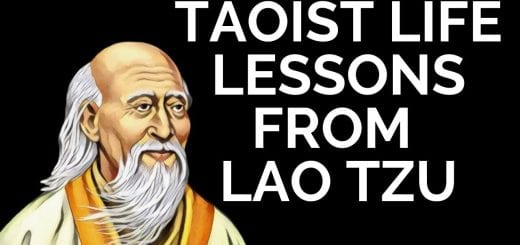EASTERN PHILOSOPHY – Lao Tzu
It’s difficult to know much for certainabout the Chinese philosopher Lao Tzu. Even his name can be a little confusing; itis also sometimes translated as Laozi or Lao TzeLao Tzu is said to have been a record keeperin the court of the central Chinese Zhou Dynastyin the 6th century B. C. , and an older contemporaryof Confucius. He may also have been entirely mythical—muchlike Homer in Western culture. Lao Tzu is said to have tired of life in theZhou court as it grew increasingly morally corrupt. So he left and rode on a water buffalo tothe western border of the Chinese empire. Although he was dressed as a farmer, the borderofficial recognised him and asked him to writedown his wisdom. According to this legend,what Lao Tzu wrote became the sacred textknown as the Tao Te Ching. After writing this piece, Lao Tzu is saidto have crossed the border and disappearedfrom history, perhaps to become a hermit. In reality, the Tao Te Ching is likely tobe the compilation of the works of many authorsover time. But stories about Lao Tzu and theTao Te Ching itself passed down through differentChinese philosophical schools for over twothousand years. Lao Tzu was the leading figure in the spiritualpractice known as Daoismwhich is more than two thousand years old,and still popular today. There are at leasttwenty million Daoists, and perhaps even halfa billion, living around the world now, especiallyin China and Taiwan. They practise meditation,chant scriptures, and worship a variety ofgods and goddesses in temples. Daoists also make pilgrimages to five sacredmountains in eastern China in order to prayat the temples and absorb spiritual energyfrom these holy places, which are believedto be governed by immortals. Daoism is deeply intertwined with other branchesof thought like Confucianism and Buddhism. There is a story about the three great Asianspiritual leaders . All were meant to have tasted vinegar. Confucius found it sour, much like he foundthe world full of degenerate people, and Buddhafound it bitter, much like he found the worldto be full of suffering. But Lao Tzu foundthe world sweet. This is telling, becauseLao Tzu’s philosophy tends to look at theapparent discord in the world and see an underlyingharmony guided by something called theDao 道 = the pathThe Tao Te Chingwhich describes the Dao, is somewhat likethe Bible: it gives instructions on how to live a good life. It discusses the“Dao” as the “way” of the world, whichis also the path to virtue, happiness, and harmony. “The way” isn’t inherently confusingor difficult. But in order to follow the Dao,we need to go beyond simply reading and thinkingabout it. Instead we must learnflowing, or effortless action. It’s a sort of purposeful acceptance ofthe way of the Dao and living in harmony with it. This might seem lofty and bizarre, but mostof Lao Tzu’s suggestions are actually verysimple. First, we ought to take more timefor stillness. “To the mind that is still,”Lao Tzu said, “the whole universe surrenders. ”We need to let go of our schedules, worriesand complex thoughts for a while and simplyexperience the world. We spend so much time rushing from one placeto the next in life, but Lao Tzu reminds us“nature does not hurry, yet everything isaccomplished. ” It is particularly importantthat we remember that certain things—grieving,growing wiser, developing a new relationship—onlyhappen on their own schedule, like the changingof leaves in the fall or the blossoming ofthe bulbs we planted months ago. When we are still and patient we also needto be open. “The usefulness of a pot comes from itsemptiness. ” Lao Tzu said. “Empty yourselfof everything, let your mind become still. ”If we are too busy, too preoccupied with anxietyor ambition, we will miss a thousand momentsof the human experience that are our naturalinheritance. We need to be awake to the waysounds of the birds in the morning, the wayother people look when they are laughing,the feeling of wind against our face. Theseexperiences reconnect us to parts of ourselves. This is another key point of Lao Tzu’s writing:we need to be in touch with our real selves. We spend a great deal of time worrying aboutwho we ought to become, but we should insteadtake time to be who we already are at heart. We might rediscover a generous impulse, ora playful side we had forgotten, or simplyan old affection for long walks. Our ego is often in the way of our true self,which must be found by being receptive tothe outside world rather than focusing onsome critical, too-ambitious internal image. “When I let go of what I am,” Lao Tzuwrote, “I become what I might be. ”Nature is particularly useful for findingourselves. Lao Tzu liked to compare different parts ofnature to different virtues. He said,”The best people are like water, which benefitsall things and does not compete with them. It stays in lowly places that others reject. This is why it is so similar to the Dao. “Each part of nature can remind us of a qualitywe admire and should cultivate ourselves—thestrength of the mountains, the resilienceof trees, the cheerfulness of flowers. Of course, there are issues that must be addressedby action, and there are times for ambition. Yet Lao Tzu’s work is important for Daoistsand non-Daoists alike, especially in a modernworld distracted by technology and focusedon what seem to be constant, sudden, and severechanges. His words serve as a reminder of the importanceof stillness, openness, and discovering buriedyet central parts of ourselves.



